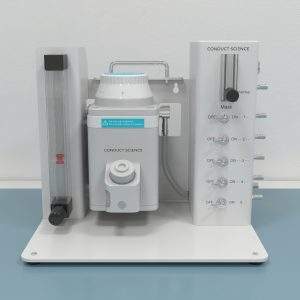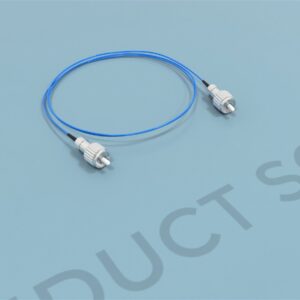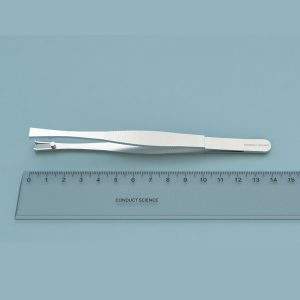$1,790.00
The Weight Drop TBI apparatus generally consists of two main parts: the U-shaped Plexiglas box and a collection sponge.
The typical weight drop mTBI equipment consists of a U-shaped Plexiglas stand, a plastic guide tube, brass weights, a clamp stand, a fishing line, and a collection sponge. The lightly anesthetized rodent is placed supine on a scored tin foil with its head directly in the pathway of the falling weight.
ConductScience offers the Weight Drop TBI apparatus.

Conduct Science is a premier manufacturer of research infrastructure, born from a mission to standardize the laboratory ecosystem. We combine industrial-grade precision with a scientist-led tech-transfer model, ensuring that every instrument we build solves a real-world experimental challenge. We replace "home-brew" setups with validated tools ranging from microsurgical suites to pathology systems. With a track record of >1,600 institutional partners and hundreds of citations, our equipment is engineered to minimize human error. We help you secure more data for less of your budget, delivering the reliability required for high-impact publication.



bool(false)

The novel weight-drop TBI model employs the use of a glancing blow to the head of a freely moving rodent which transmits acceleration, deceleration, and rotational forces onto the brain. Recently, an increasing amount of scientific evidence has come to light indicating that childhood embodies a major risk period for mild traumatic brain injuries resulting from sports-related accidents, motor vehicle injuries, and concussions from falls. However, there has been a significant lack of progress in the area of developing a reliable animal model of mTBI. While the availability of techniques used for inducing moderate and severe traumatic brain injury (TBI) is widespread, very few of these methods have been extended to generate mild, closed head injuries in rodents.
Due to the fact that mild traumatic brain injury (mTBI) is thrice as more likely to occur than moderate and severe brain injury collectively, there is a growing need to develop a dependable model of mTBI to assist the research related to physiopathology, neurobiological outcomes and behavioral consequences, and therapeutic procedures.
When specifically carried out on juvenile rodents, the weight-drop mTBI model generates clinically relevant behavioral outcomes that are depictive of post-concussion symptoms. The simple and basic nature of this method provides researchers with a dependable model of mTBI that can be utilized in an extensive range of behavioral, molecular, and genetic studies.
Weight Drop mTBI apparatus generally consists of two main parts: the U-shaped Plexiglas box and the collection sponge.
The default weight drop mTBI equipment consists of the following:
The lightly anesthetized rodent is placed supine on a scored tin foil with its head directly in the pathway of the falling weight.
All animals must be housed with freely accessible food and water along with properly maintained optimal room temperature. 30 days Post-natal, juvenile rodents can be used for taking part in the experiment.
The overall goal of the weight-drop mTBI model is to generate mild traumatic brain injury in juvenile rodents. This is accomplished by first preparing the injury induction platform. Attach a metal loop to the top end of the desired weight allowing the fishing line to be fastened to the weight. A tin foil is scored with a razor-sharp blade making certain that the scored tin foil supports the bodyweight of the rodent. The foil is then placed on the U-shaped stage made of Plexiglas and securely taped to it. The U-shaped plastic stage is placed in the accurate position under the guide tube made of clear plastic. The plastic guide tube is held in place with a clamp stand and positioned above the scored tin foil. The fishing line is then attached through the metal loop to the weight ensuring that the bottom of the weight hangs freely over the scored tin foil. The fishing line is then connected to the clamp stand, and the weight is drawn up through the plastic guide tube with the fishing line and secured in its position with an Allen key pin.
Next, a rodent is taken and lightly anesthetized until it is non-responsive to a paw or tail pinch. The anesthetized rodent is placed face down on the scored tin foil. Once in place, the Allen key pin is pulled allowing the weight to drop and generate a glancing blow to the head. The animal swiftly undergoes a 180° rotation and lands on the collection sponge. The animal is then placed in a supine position and the time it takes to right itself is recorded.
Like any technical method, certain stages of the protocol are predominantly important to generate reliable outcomes. Primarily, the tin foil should be scored properly to produce the desired effect. If the tin foil is not effectively scored, the force exerted by the weight for the duration of the glancing blow will not be sufficient to thrust the juvenile rodent through the tin foil onto the collection sponge. Hence, the desired rotational acceleration and deceleration will not occur. Secondly, during the induction of the mTBI injury, the level of anesthetic that each rodent is exposed to should remain consistent. An important benefit of this technique over countless other TBI methods is the low level and duration of anesthesiology. However, the juvenile rodent must be non-responsive to a toe or tail pinch to make certain that they do not wake up on the stage before the injury is produced.
Reliable animal models for inducing mild traumatic brain injury can make use of the modified weight drop mTBI device to induce an injury that strongly embodies the pathophysiology and symptoms related to concussions and repetitive mTBI in the adolescent populations. The implications of this technique extend to the therapy of pediatric concussion and mild traumatic brain injury because the model induces clinically relevant symptomology in a heterogeneous fashion.
The present definition of mTBI states that the injury must be the outcome of acceleration and deceleration forces affiliated with blunt trauma. Therefore, the modified weight drop model described above is the ideal method to use in experiments aiming to study mTBI and concussion-like injuries as it makes use of a glancing impact to transmit quick rotational acceleration and deceleration forces to the brain of the unrestrained animal. These forces imitate the biomechanical forces specifically linked to sports-related injuries and motor vehicle accidents (Mychasiuk et al., 2014).
Additionally, this model can be easily modified to observe repetitive mTBI, an incidence that is rising as a severe medical and socioeconomic issue. Evidence indicates that rodents may possibly be exposed to up to 10 distinctive mTBIs with minimum mortality rates. Furthermore, the technique is inexpensive and can be executed quickly, allowing for a highly thorough examination of numerous therapeutic compounds and treatment controls.
The main advantage of the weight drop mTBI model over others is that the animals are only briefly anesthetized. While the majority of the present TBI techniques impose such intense injuries, it is frequently hard to induce another injury and almost impossible to study repetitive TBI without widespread damage to the entire cortex. However, in the weight drop mTBI technique, a closed head injury is inflicted with no overt damage to the brain which allows the researcher to repeat the injury in the same animal several times.
Another advantage of the weight drop mTBI model is that there’s a rotational component to the injury that generates a more clinically relevant concussive-like symptomology. On the basis of the biomechanical pathophysiology of the induced injury and the behavioral outcomes studied, the modified weight-drop mTBI technique has emerged as a dependable model for the examination of pediatric TBI and concussion. Although preliminary studies of this new model have detected some fundamental molecular and structural transformations, further studies will be required to determine how the brain acts in response to a TBI with this injury etiology.
Mychasiuk, R., Farran, A., Angoa-Perez, M., Briggs, D., Kuhn, D., Esser, M. J. A Novel Model of Mild Traumatic Brain Injury for Juvenile Rats. J. Vis. Exp. (94), e51820, doi:10.3791/51820 (2014)
| Brand | ConductScience |
|---|---|
| Size | Rat, Mouse |
You must be logged in to post a review.
There are no questions yet. Be the first to ask a question about this product.
Reviews
There are no reviews yet.